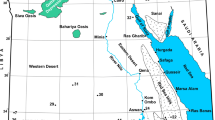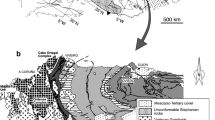Abstract
During the course of mapping of active faults in the northwestern Outer Himalaya (using CORONA photographs, multispectral satellite data of Indian Remote Sensing satellite (IRS) and aerial photographs) we have identified an isolated basin of Quaternary and Holocene sediments resting unconformably on Siwaliks, around Parduni, in the northwestern Dehra Dun (Doon) valley. The region around Parduni is tectonically very complex and is traversed by active thrust faults to its north and south and strike slip faults to its east and west. The uplift and southward shift along the strike slip faults on both sides and the Markanda thrust edging to its south, the Parduni has developed as an intradun basin and now remains isolated from the main Doon valley. Based on the OSL age data widespread deposition of Quaternary alluvial fan sediments, the dun gravels, is inferred to have initiated around 34 ka BP in the western part of the Doon valley, while the sedimentation in the Parduni Basin started only around 27 ka BP, which more or less ceased around 20 ka. The southward movement of the Parduni Basin as a piggyback basin is ongoing with recent alluvial deposits covering the dun gravels tectonically overlain by the Siwalik sandstone and mudstones in the hanging wall of the Markanda thrust. The present communication discusses the development and evolution of the Parduni Basin vis-à-vis the configuration of the Doon valley in the northwestern Outer Himalaya and the prevalence of tectonics expressed or demonstrated in the active Himalayan Front.
Similar content being viewed by others
References
Aitken, M.J. (1985) Thermo-luminescence dating, Academic Press, London, 359p.
Arur, M.G. and Hasija, N.L. (1986) Crustal movement studies across Ganga Tear Fault (in Siwaliks) at Haridwar in Uttar Pradesh, India. Proc. Internat. Symp. Neotectonics in South Asia, v.1, pp.332–344.
Burrard, S.G. and Hayden, H.H. (1933) A sketch of the geography and geology of the Himalayan mountain and Tibet., Govt. of India, 369p.
Butler, R.W.H. (1982) The terminology of structures in thrust belts. Jour. Struc. Geol., v.4, pp.239–245.
Dahlstrom, C.D.A. (1970) Structural geology in the eastern margin of the Canadian Rocky mountains. Canadian Petroleum Geol. Bull., v.18, pp.332–406.
Joshi, D.D., Kandpal. G.C., John, B. and Pande. P. (2005) Morphotectonic and paleoseismic studies along the Yamuna Tear zone-Himalayan Frontal Belt, India. Geol. Surv. India, Spec. Publ., v.85, pp.225–236.
Kapur, S.K.C. (1934) Gazetteer of the Sirmur State-Part A. Punjab India. Punjab Government 129p.
Malik, J.N. and Nakata, T. (2003) Active faults and related Late Quaternary deformation along the Northwestern Himalayan Frontal Zone. Annals of Geophysics, v.46(5), pp.917–936.
Murray, A.S. and Wintle, A.G. (2000) Luminescence dating of quartz using an improved single-aliquot regenerative-dose protocol. Radiation Measurements, v.32, pp.57–73.
Murray, A.S. and Wintle, A.G. (2003) The single-aliquot regenerative-dose protocol: potential for improvements in reliability. Radiation Measurements, v.37, pp.377–381.
Nakata, T. (1972) Geomorphic history and crustal movements of the foothills of the Himalayas. Report of Tohoku University Japan, 7th series (Geography), 22, pp.39–177.
Nakata, T. (1989) Active faults of the Himalaya of India and Nepal. Geol. Soc. Amer., Spec. Paper 232, pp.243–264.
Nossin, J.J. (1971) Outline of the geomorphology of the Doon valley northern UP India. Zietschrift fur Geomorphologie, v.12, pp.18–50.
Oatney, E.M., Virdi, N.S. and Yeats, R.S. (2001) Contribution of Trans-YamunaActive Fault System towards hanging wall strain release above the décollement, Himalayan Foothills of Northwest India. Himalayan Geol., v.22(2), pp.9–27.
Philip, G. (1996) Landsat Thematic Mapper data analysis for Quaternary tectonics in parts of Doon valley, NW Himalaya, India. Internat. Jour. Remote Sensing, v.17(1), pp.143–153.
Philip, G. and Sah, M.P. (1999) Geomorphic signatures for active tectonics in the Trans-Yamuna segment of the western Doon valley, NW Himalaya. Internat. Jour. Applied Earth Observation and Geoinformation, v.1(1), pp.54–63.
Philip, G. and Virdi, N.S. (2006) Co-existing Compressional and Extensional Regimes along the Himalayan Front vis-à-vis Active Faults near Singhauli, Haryana, India. Curr. Sci.e, v.90(9), pp.1267–1271.
Philip, G. and Virdi, N.S. (2007) Active Faults and Neotectonic Activity in the Pinjaur Dun, Northwestern Frontal Himalaya, India. Curr. Sci., v.92(4), pp.532–542.
Raiverman, V., Kunte, S.V. and Mukherjee, A. (1983) Basin geometry, Cenozoic sedimentation and hydrocarbon prospects in Northwestern Himalaya and Indo-Gangetic plains. Petroleum Asia Jour., v.6, pp.67–92.
Singh A.K., Prakash, B., Mohindra, R., Thomas, J.V. and Singhvi, A.K. (2001) Quaternary alluvial fan sedimentation in the Dehradun piggyback basin, NW Himalaya; tectonic and paleoclimatic implications. Basin Res., v.13, pp.447–471.
Sinhwal, H.S., Agarwal, P.N., King, G.C.P. and Gaur, V.K. (1973) Interpretation of measured movement at a Himalayan (Nahan) thrust: Geophys. Jour., Roy. Astron. Soc., v.34, pp.203–210.
Swamy, M.M. (1986) Neotectonic movements across thrust planes and younger fault planes in Giri Hydroelectric project area, District Sirmur, Himachal Pradesh, India. Proc. Internat. Symp. Neotectonics in South Asia, Dehradun, India, v.2, pp.58–67.
Thakur, V.C, Pandey, A.K. and Suresh, N. (2007) Late Quaternary-Holocene evolution of dun structure and the Himalayan Frontal fault zone of the Garhwal sub-Himalaya, NW India. Jour. Asian Earth Sci., v.29, pp.305–319.
Virdi, N.S. and Philip, G. (2006) Neotectonic activity and its control on drainage changes in the northwestern Frontal Himalaya between the Rivers Satluj and Yamuna. Jour. Himalayan Geol., v.27(2), pp.129–143.
Virdi, N.S., Philip, G. and Bhattacharya, S. (2006) Neotectonic activity in Markanda and Bata River Basins, Western Doon valley, NW Himalaya: A morphotectonic approach. Internat. Jour. Remote Sensing, v.27(10), pp.2093–2099.
Author information
Authors and Affiliations
Corresponding author
Rights and permissions
About this article
Cite this article
Philip, G., Virdi, N.S. & Suresh, N. Morphotectonic evolution of Parduni Basin: An intradun piggyback basin in western Doon valley, NW Outer Himalaya. J Geol Soc India 74, 189–199 (2009). https://doi.org/10.1007/s12594-009-0121-x
Received:
Revised:
Published:
Issue Date:
DOI: https://doi.org/10.1007/s12594-009-0121-x




